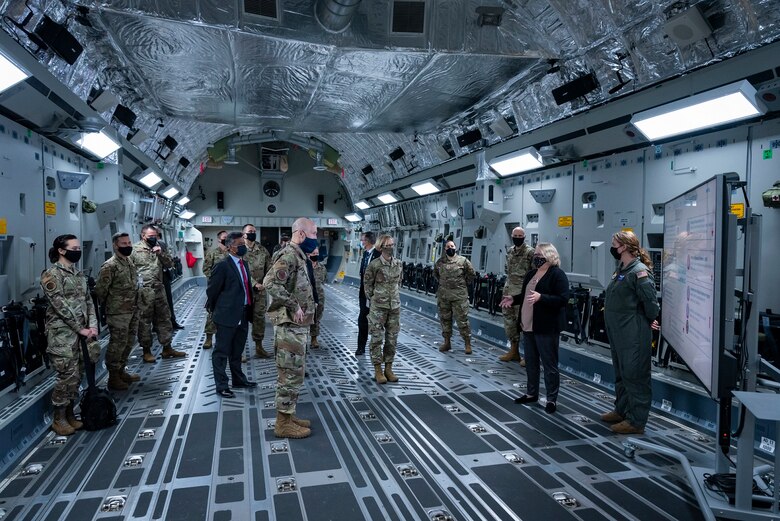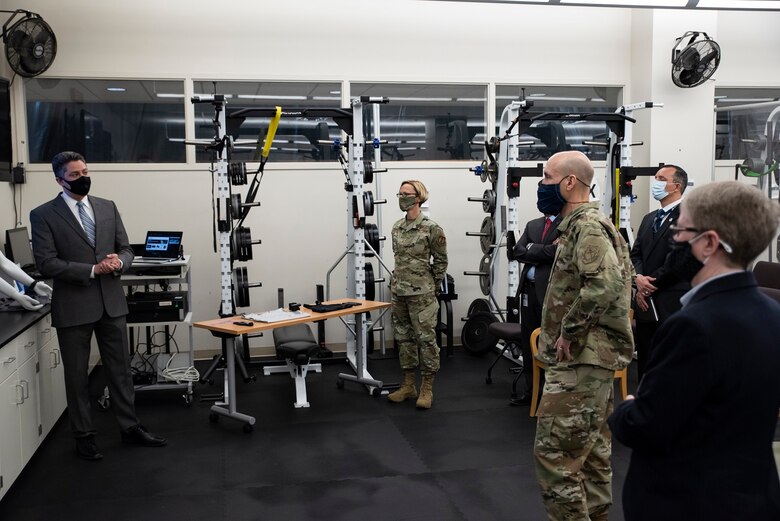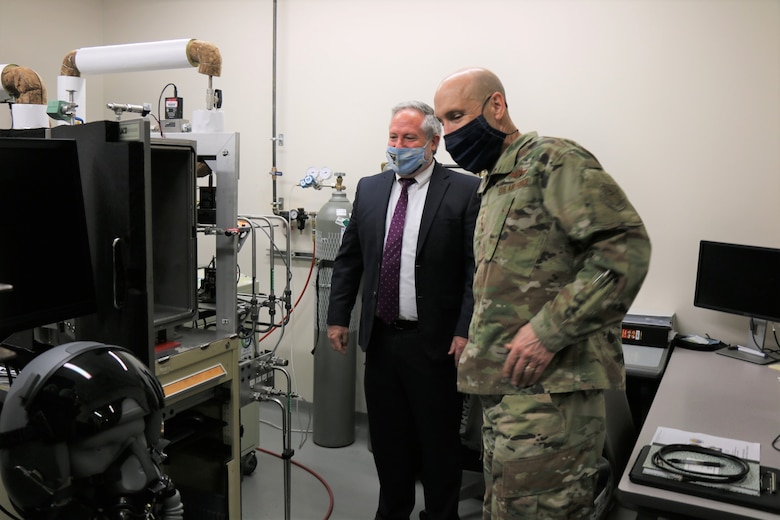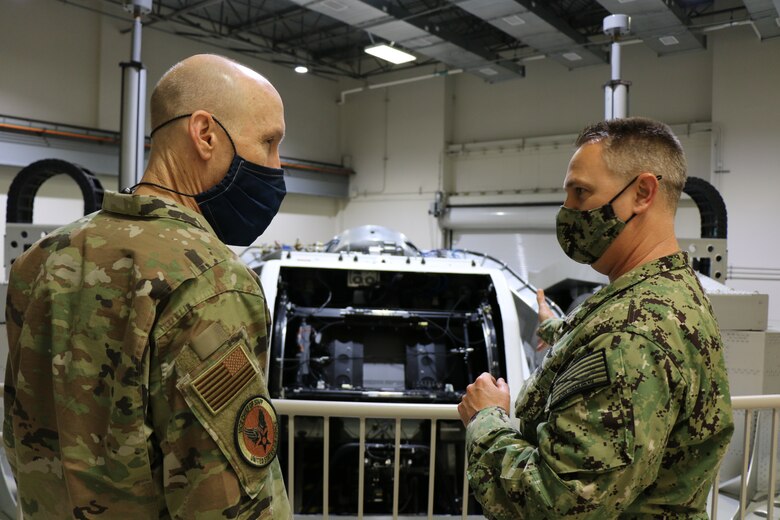Vice Chief of Staff of the Air Force Gen. David W. Allvin visited various Air Force Research Laboratory facilities April 26 to see how the 711th Human Performance Wing is leveraging data and collaboration to enable, enhance, sustain, and restore Airmen and Guardians throughout their career lifecycle.
Allvin received a full day of briefings and demonstrations by the 711th HPW's Airman Systems Directorate and U.S. Air Force School of Aerospace Medicine, including demonstrations of large-scale laboratory devices used to analyze and monitor human performance.
Allvin commended the work being done in the 711th HPW during a luncheon with members of the junior force as well as a ceremony in which he awarded select top-performing 711th HPW personnel with his personal military coins.
"I'm excited to be here because it's one of those keys to the future that doesn't get a lot of press and headlines, but the types of things this organization is doing while everything else is trying to catch up to the National Defense Strategy in competition with adversaries - this is the stuff where we understand not only about the readiness of Airmen right now but building an understanding of how we work, what science is teaching us, and how we can leverage that to make sure we're not only great when we're doing the mission but great when we're at home with our families, when we're in, when we're out, when we're gone," Allvin said. "[It makes us] better whole Airmen. That's one of the best competitive advantages we can get. So, being able to come up here and spend some time, it reenergizes me."
Allvin and his staff traveled from Joint Base Andrews, Maryland, for this daytrip to Wright-Patterson Air Force Base where he was greeted by top base officials including: Gen. Arnold W. Bunch Jr., commander of Air Force Materiel Command, Brig. Gen. Heather Pringle, AFRL commander, Col. Patrick Miller, 88th Air Base Wing commander and Darrell Phillipson, 711th HPW acting director.
In the morning, USAFSAM leaders briefed Allvin on medical flight screening, aeromedical consultation efforts and the Air Force Operational Support Team Program. The OST program is the only data-driven and outcome-informed embedded medical effort in the Air Force today, and each team consists of musculoskeletal and mental-health experts along with a program manager. All medics assigned to an embedded medical mission are brought to the school for one week to collaborate across specialties and learn skills critical to embedding with Airmen.
He was also shown USAFSAM's "High Bay," which includes multiple airplane fuselages that allow aeromedical personnel to train for aeromedical evacuation in as close to real-world scenarios without taking flight. By perfecting on the ground, trainees are better prepared for their follow-on training in the air.
After transitioning to the ASD, Allvin, an avid cyclist, showed particular interest in a presentation about the Airman Data Analysis and Performance Tracking System developed in the Signature Tracking for Optimized Nutrition and Training lab. Presented by Drs. James Christensen and Adam Strang, ADAPTS ingests and aggregates data from human performance technologies, such as "wearables" like a FitBit or Garmin, and applies custom analytics and algorithms to create real-time visualizations with actionable information.
"Before wearables became the hype, we were in this space quite a bit," said Dr. Rajesh Naik, 711th HPW chief scientist. "We were looking at biomarkers: what are the key attributes? Is it heart rate variability? Is it SpO2 (oxygen saturation) levels? So, we've been doing a lot of foundational research going back almost 10 years. And we identified heart rate variability as one of the biomarkers of fatigue or stress that you could use reliably to monitor individuals. And then you have this explosion, due to confluence of AI and microelectronics with biosciences. It's caused such a huge inflection in the development of wearable devices."
With the tracking of data by ADAPTS, the STRONG Lab seeks to improve support to optimize Airman performance, reduce workload for service members and improve decision making for operators, commanders and support, Christensen explained.
The presentation sparked discussion of potential use of the system to detect COVID-19 symptoms or other illness to encourage quarantine as well as continuously monitor Airmen's fitness to prevent injury and long-term disability brought on by inadequate training for the mandated annual physical fitness test.
"This is one of the cases where the Airman Systems Directorate and USAFSAM being in the same organization can be really helpful because each looks at a different side of the equation and merges them together for some great synergistic opportunities," said Stephanie Miller, ASD acting director.
The ASD partnered with the Defense Health Agency in an ongoing study about routine use of wearables on and off duty, what the potential is for mandatory use, especially in specific Air Force career fields, and the privacy and policy implications. Proof-of-concept testing as a Program of Record is currently taking place in the Air Force Special Operations Command with rollout to 20,000-25,000 users happening soon. The ASD has already put 9,000 device sets in the hands of all the services, including the Air Force's Air Education & Training Command and Air Combat Command.
Researchers in the 711th HPW also test wearables in the centrifuge, which Allvin observed on the tour. The massive centrifuge teaches aeromedical students about the effects of gravity forces on human physiology and gives fast-jet aviators the capability to experience up to 9 Gs, or nine times the normal force of gravity, in a controlled environment to measure a pilot's ability to counteract the effects and prevent G-force-induced loss of consciousness. In addition, Allvin toured 711th HPW's research altitude chambers.
"We're able to look at the system as you would a weapons system, to track performance and provide information to keep people in the fight," said Dr. David Burch, ASD Airman Biosciences Division.
Allvin's visit also included a stop at the Naval Medical Research Unit-Dayton, a neighbor and frequent partner of the 711th HPW. As a result of the 2005 Base Realignment and Closure, or BRAC, the Naval Aerospace Medical Research Laboratory, previously located in Pensacola, Florida, was moved to Wright-Patterson AFB with the intention of developing and forming a center of excellence in aerospace medicine research for the Air Force and the Navy. In 2010, NAMRL and the Navy's Environmental Health Effects Laboratory merged and were established as one command, NAMRU-Dayton.
"NAMRU-Dayton is committed to performing operationally relevant and important research to promote the health and readiness of the warfighter, and we can accomplish that best by growing our partnership with the 711th," said Navy Capt. Nimfa Teneza-Mora, NAMRU-Dayton commanding officer.
While presenting NAMRU-Dayton's facilities, Dr. Richard Arnold, NAMRL director, discussed collaborative research into unexplained physiological episodes related to altitude, such as the F-22 Raptor issues. He discussed NAMRL's effort in evaluating sensors for monitoring oxygen, carbon dioxide, and pressures that can be embedded in a flight mask allowing testing of many commercial-off-the-shelf sensors presented to the Air Force and Navy that failed to function in the challenging cockpit environment.
Leadership in NAMRU-Dayton also provided demonstration of its $19-million, 245,000-pound disorientation research device, nicknamed "the Kraken." The 4,500-horsepower device allows researchers to create realistic simultaneous motion simulations using all six degrees of freedom and up to 3 Gs of planetary motion with horizontal travel up to 16 ½ feet.
"The great thing about these devices - the centrifuge, the chambers, the Kraken - is not that they're great, big devices, it's that they're research devices. All of them are customizable, and they can do things beyond the limits of what we can conceive we need on the horizon. It's a researcher's dream, which brings talent to this ecosphere," Phillipson said.
Allvin's tour wrapped with discussion on biotechnology and live, virtual, and constructive science and technology efforts at the 711th HPW.
"What the entire enterprise does is it moves things forward. It's hugely valuable," Allvin concluded.

Air Force Vice Chief of Staff Gen. David W. Allvin (center) is briefed about ready medics and aeromedical evacuation training by Elizabeth Miller, Air Force School of Aerospace Medicine En Route Care Training Department deputy chair, in a C-17 Globemaster III trainer during Allvin's visit to Air Force Research Laboratory's 711th Human Performance Wing, April 26, 2021 at Wright-Patterson Air Force Base, Ohio. (U.S. Air Force photo by Richard Eldridge)

Dr. James Christensen, Airman Sensing and Assessment Product Line lead at the Airman Systems Directorate, speaks with Air Force Vice Chief of Staff Gen. David W. Allvin about wearable sensors and technology during his visit to Air Force Research Laboratory's 711th Human Performance Wing, April 26, 2021 at Wright-Patterson Air Force Base, Ohio. (U.S. Air Force photo by Richard Eldridge)

Dr. David Burch, (center back) Airman Systems Directorate's Airman Biosciences Division, Lt. Col. Nathan Maertens (left middle), Aerospace Physiology division chief at the Air Force School of Aerospace Medicine, Brig. Gen. Heather Pringle, Air Force Research Laboratory commander (center front) and Dr. Rajesh Naik, 711th Human Performance Wing chief scientist (right), stand in front of a centrifuge while discussing aerospace physiology partnerships with Air Force Vice Chief of Staff Gen. David W. Allvin (center) during his visit to AFRL's 711th HPW, April 26, 2021 at Wright-Patterson Air Force Base, Ohio. (U.S. Air Force photo by Richard Eldridge)

Dr. Richard Arnold, Naval Aerospace Medical Research Laboratory, NAMRU-Dayton director, speaks with Air Force Vice Chief of Staff Gen. David W. Allvin in the sensors laboratory during his visit to Air Force Research Laboratory's 711th Human Performance Wing, Apr. 26, 2021 at Wright-Patterson Air Force Base, Ohio. Allvin was briefed on the Navy-Air Force joint capability in aerospace physiology research at Wright-Patterson AFB. (U.S. Navy photo by Megan Mudersbach)

Air Force Vice Chief of Staff Gen. David W. Allvin and Navy Capt. Richard Folga, Engineering and Technical Services department head and program manager, stand on a balcony, April 28, 2021 at the Naval Aerospace Medical Research Laboratory, NAMRU-Dayton, in front of the Disorientation Research Device, also known as "the Kraken," a one-of-a-kind national scientific asset that provides a platform for basic science and applied research through simulation of aviation environments with customizable capsule configurations supporting one or two side-by-side occupants. (U.S. Navy photo by Megan Mudersbach)






